
The global generic drug market is on track to become a trillion-dollar industry within the next decade. While branded drugs grab headlines for their price tags, it’s the quiet, cost-effective generics that are keeping healthcare systems afloat - especially as populations age and chronic diseases surge. By 2030, the market could be worth anywhere between $530 billion and $800 billion, depending on which analyst you trust. But this isn’t just about numbers. It’s about access, survival, and who gets to play in this game.
Why Generic Drugs Are More Important Than Ever
Generic drugs aren’t cheap knockoffs. They’re exact copies of brand-name medications, approved by regulators like the FDA and EMA, with the same active ingredients, strength, and effectiveness. The only difference? They cost 80-90% less. That’s not a marketing claim - it’s fact. A 30-day supply of metformin, a common diabetes drug, might cost $4 as a generic but over $100 as a branded version in the U.S. before insurance. The shift toward generics isn’t optional anymore. In the U.S., over 90% of prescriptions filled are for generics. In the U.K. and Germany, that number is even higher. Why? Because healthcare budgets are stretched thin. Governments, insurers, and patients alike are pushing for affordability. When a drug like Humira - which once cost over $70,000 a year - loses patent protection, the drop in price isn’t just a win for patients. It’s a lifeline for public health systems.The Patent Cliff Is Here - And It’s Massive
The biggest driver of growth isn’t innovation. It’s expiration. Between 2025 and 2030, drugs generating $217-$236 billion in annual sales will lose patent protection. That’s like wiping out a small country’s entire annual healthcare budget and replacing it with cheaper alternatives. The biggest targets? Biologics. These are complex, injectable drugs used for cancer, autoimmune diseases, and diabetes. Drugs like ustekinumab (Stelara), vedolizumab (Entyvio), and liraglutide (Victoza) are about to go generic. But here’s the catch: these aren’t simple pills. They’re biologics - and their generic versions are called biosimilars. They’re harder to make, harder to test, and cost more to develop. But once approved, they still slash prices by 30-70%. Biosimilars are growing at 8.2% annually - faster than traditional generics. The EU has streamlined approval, and Japan is fast-tracking them. That means more options, faster. By 2029, the biosimilar market alone could hit $25 billion in oncology and immunology drugs.Where the Growth Is: India, China, and the Asia-Pacific Surge
The U.S. and Europe are the biggest buyers - but the fastest growth? That’s in Asia. India supplies 20% of the world’s generic drugs and 60% of its vaccines. It’s not just volume. It’s cost. Indian manufacturers like Sun Pharma and Dr. Reddy’s have built entire business models around making high-quality generics at rock-bottom prices. Their secret? Vertical integration, cheap labor, and decades of experience. China is playing a different game. Instead of competing on price alone, it’s using government-backed volume-based procurement. Think of it like a bulk auction: the government says, “We need 10 million doses of this blood pressure drug. Who can make it cheapest?” The lowest bidder wins - and sets the global price. That’s why generic prices in China are often half of what they are in the U.S. This pressure is rippling out. A generic drug made in India or China can undercut European or U.S. manufacturers, forcing them to either cut costs or get out. The result? A global race to the bottom - but one that saves millions of lives.
The Hidden Winners: Complex Generics and Tech-Driven Supply Chains
Not all generics are created equal. Simple pills like ibuprofen are easy to copy. But what about inhalers? Injectable suspensions? Patch systems? These are “complex generics” - and they’re where the real money is going. Take GLP-1 agonists like liraglutide. These are injectable diabetes and weight-loss drugs. The branded versions (Victoza, Saxenda) cost thousands. The generics? Still in development. But the first companies to crack the formulation - matching the drug’s stability, delivery, and absorption - will dominate. That requires advanced manufacturing, precise chemistry, and regulatory expertise. Meanwhile, tech is changing how these drugs get to patients. Pharmacies are using AI to predict refill patterns. Apps remind people to take their meds. Automated dispensing systems reduce errors. These aren’t flashy, but they boost adherence - and that’s huge. A patient who takes their generic blood pressure pill every day is less likely to end up in the hospital. That saves money for insurers and governments.Who’s Winning the Race?
The market is split into three tiers:- Big players: Teva, Viatris, Sandoz (Novartis), and Amneal - these U.S. and European giants have the scale, regulatory muscle, and global distribution to compete everywhere.
- Emerging giants: Indian and Chinese firms like Cipla, Dr. Reddy’s, and Sinopharm - they’re growing fast, especially in low- and middle-income countries.
- Niche innovators: Smaller companies focusing on complex generics or biosimilars. They’re the ones betting on the next wave - like biosimilar versions of Ozempic or Dupixent.

The Challenges: Price Pressure, Regulation, and Quality Control
It’s not all growth and opportunity. The biggest threat? Price erosion. In markets like the U.S., where insurers negotiate aggressively, generic prices keep falling. A drug that sold for $10 in 2020 might sell for $1.50 by 2025. That’s great for patients. But it’s brutal for manufacturers. Margins are so tight that many small companies can’t survive. Then there’s regulation. The FDA has cracked down on manufacturing quality. In 2023, over 100 generic drug plants were flagged for data integrity issues. Some were shut down. That caused shortages of essential drugs like antibiotics and heart medications. And let’s not forget patent litigation. Brand-name companies often file lawsuits to delay generic entry - sometimes for years. These legal battles can cost hundreds of millions. And while they delay competition, they also raise costs for everyone.What’s Next? The Road to 2030
By 2030, the generic drug market will look very different:- Biosimilars will make up at least 20% of total generic sales - up from less than 5% today.
- India and China will control over 60% of global manufacturing capacity.
- Complex generics will overtake simple pills in revenue growth.
- AI and automation will reduce production costs by 25-30% in top-tier facilities.
- More countries will adopt volume-based procurement - forcing global price alignment.
Final Thoughts: More Than Just a Bargain
Generic drugs aren’t a stopgap. They’re the backbone of modern healthcare. Without them, millions wouldn’t be able to afford insulin, statins, or blood thinners. They’re not just cheaper alternatives - they’re essential tools for equity. The next five years will test the system. Will manufacturers keep quality high as prices fall? Will regulators keep pace with complex drugs? Will governments protect access while controlling costs? One thing’s clear: the future of healthcare doesn’t depend on the next miracle drug. It depends on whether we can keep making the old ones affordable.Are generic drugs as safe and effective as brand-name drugs?
Yes. Generic drugs must meet the same strict standards as brand-name drugs. Regulators like the FDA and EMA require generics to have the same active ingredient, strength, dosage form, and route of administration. They must also prove they’re absorbed into the body at the same rate and extent. Thousands of studies and real-world data confirm they work just as well.
Why do generic drugs cost so much less?
Generic manufacturers don’t have to repeat expensive clinical trials. They rely on the original drug’s safety and efficacy data. Their main costs are manufacturing and regulatory approval - which are far lower than developing a new drug from scratch. No marketing budgets, no patent recovery costs - just production.
What’s the difference between a generic and a biosimilar?
Generics are exact copies of small-molecule drugs - like pills or tablets. Biosimilars are copies of complex biological drugs - like injectables made from living cells. Because biologics are made from living organisms, biosimilars can’t be exact copies. They’re “similar enough” to have the same clinical effect. They require more testing and are more expensive to produce.
Which countries are leading in generic drug production?
India is the world’s largest supplier by volume, providing 20% of global generics and 60% of vaccines. China leads in manufacturing scale and price-setting through government tenders. The U.S. and Germany are major consumers and regulators, but produce far less than they consume.
Will generic drug prices keep falling?
Yes - but only for simple generics. Prices for basic pills like metformin or atorvastatin are already near their floor. The next wave of price drops will come from biosimilars and complex generics, which are harder to make and still have room to reduce costs. In markets like the U.S. and EU, competition will keep pushing prices down - unless regulations change.


